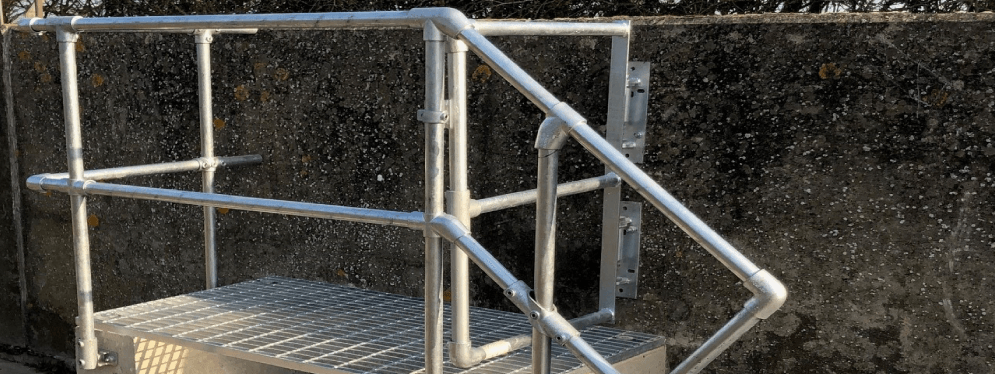Falls from height make up a significant number of injuries within the workplace. More than 50% of workplace falls within an internal environment take place either on a ladder or elevated platform.
It is highly recommended by the Health and Safety Executive (HSE) to install a safety system to minimise these risks “Where regular or frequent access to height is required, permanent safe access arrangements should be installed.”

Installing safety gates is crucial for ensuring the well-being and safety of workers in elevated areas and to control access to restricted or hazardous zones.
By installing safety gates, you not only prioritise the safety of your workforce but also fulfil your health and safety obligations and legal requirements. These gates ensure compliance with the latest regulations, keeping you up to date with the most current safety standards.
Now, let's take a closer look at the safety requirements:
The British standard BS EN ISO 14122-3:2016 is a comprehensive and revised standard that was introduced in 2001 to establish the necessary safety requirements in situations where permanent access is required, such as on stairs, ladders, and around guardrails.
Self-closing safety gates have proven to be an indispensable component of safety systems, effectively preventing unauthorised access to hazardous areas such as platforms, walkways, and stairways. These gates are specifically designed to automatically close after a person passes through them, ensuring high levels of security and fall prevention.
The guidelines provided by the standard are crucial in ensuring the design and installation of self-closing safety gates. These guidelines cover various aspects, including dimension requirements and installation considerations. Emphasising the need for gates to be robust, durable, and resistant to accidental opening, the requirements ensure that the highest safety standards are met.
To comply with BS EN ISO 14122-3:2016 Self Closing Safety Gates must meet the requirements of the adjacent guard-rails. Key requirements include the following:
- Have top rail finish height of minimum 1100mm
- Have no more than 500mm gaps within the gate frame or from the lower gate rail to the floor
- The gate must be able to hold in a closed position when not locked
- Easily openable onto platforms or walking areas
- Close against a firm stop to prevent users from pushing against the gate and falling through the opening

Complying with BS EN ISO 14122-3:2016 not only ensures adherence to legal requirements but also signifies a commitment to the overall well-being and safety of the workforce. By consistently implementing self-closing safety gates that meet the standards, companies demonstrate their dedication to providing a safe working environment.
The continuous improvement and evolution of safety standards, as reflected in this revised standard, highlight the importance of staying up to date with the latest regulations. By developing and implementing the necessary safety measures, companies can effectively protect their workers and maintain a workplace environment that prioritises safety above all else.
Let's explore the various locations where safety gates can be installed:
Self-closing safety gates offer versatile applications both in external and internal industrial and construction settings.
Internally: Self-closing safety gates are the perfect solution for blocking off hazardous or restricted areas. Equipped with spring-loaded mechanisms, these gates effectively secure machinery zones and serve as access points for staircases, platforms, mezzanines, and elevated walkways. By preventing falls and controlling entry, they significantly enhance safety within factories and warehouses.
Externally: Self-closing safety gates seamlessly integrate with other working-at-height systems, such as access ladders or roof guardrails, to create a comprehensive fall prevention system. This combination is particularly useful in areas like roof access hatches, roof edges, and ladder access points, where controlled access is absolutely crucial in order to prevent accidents and even deaths by falling from height.
The ability for self-closing safety gates to adapt to various settings and configurations ensures that they can be utilised in a wide range of applications. From securing elevated walkways to blocking off hazardous machinery areas, these gates provide peace of mind and ensure the well-being of workers.
What solutions do we supply?
At Lockinex, we understand the importance of reliable and durable safety equipment. That's why our self-closing safety gates comply with BS EN ISO 14122-3:2016 and are designed to meet the highest safety standards.
Unlike other suppliers, Lockinex self-closing gates are fully compliant with BS EN ISO 14122:-3:2016 and come in a kit form made from our popular galvanised key clamp and steel tube range.
With a 180-degree swing capability and the option for clockwise or counter clockwise operation, our gates provide versatility and ease of use.

Available in either Full Height (including toe board) or Half Height form, our gates are easily compatible with our Access Ladder kits, Key Clamp Guardrail and our Collective Fall Protection Roof Guardrail.

We also provide a comprehensive range of components specifically designed for welding and fabrication to our full height and half height gates. You have the option to select from our collection, which includes the Enclosed Gate Spring, Open Gate Spring, and the Gate Latch & Striking Pin
If you're interested in installing a safety gate or have an upcoming project that requires our assistance, please don't hesitate to contact our dedicated sales team today by sending an email to sales@lockinex.com.
We are here to provide you with the best safety solutions for your specific needs.

